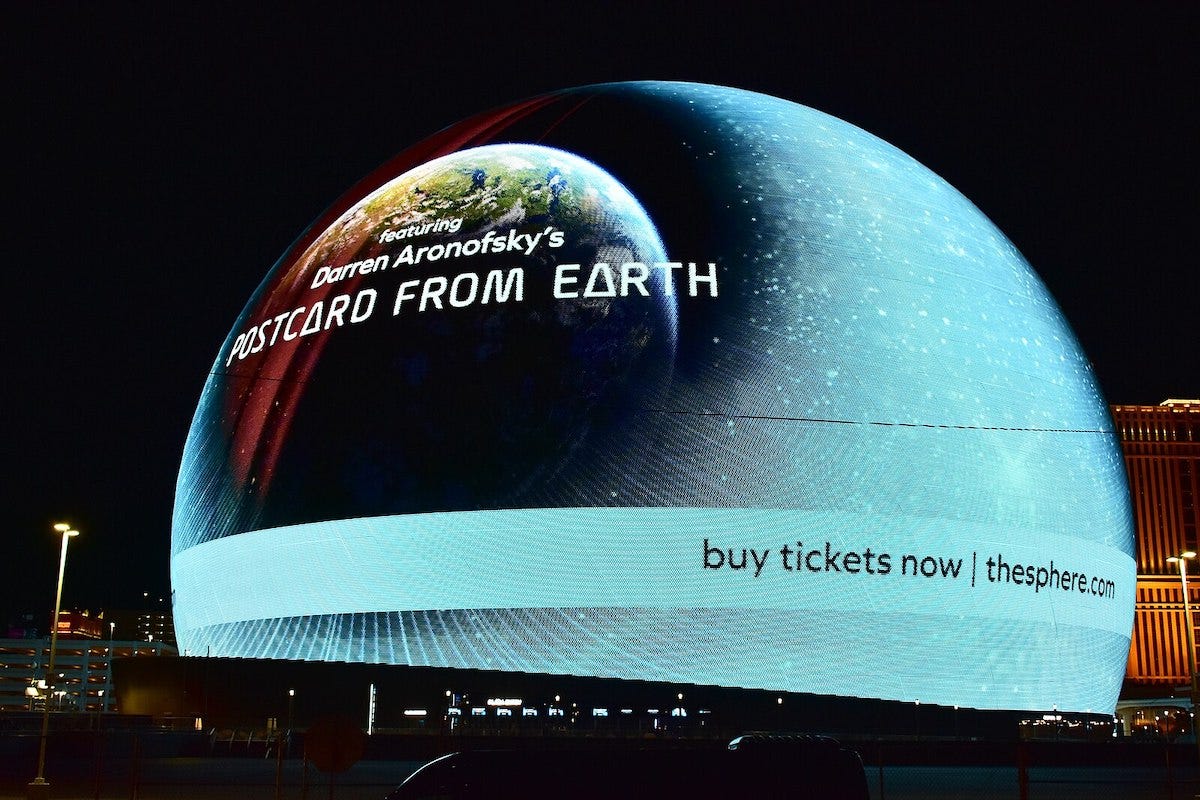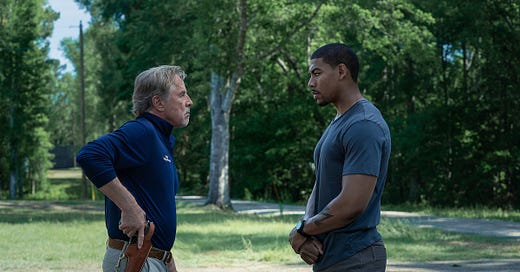
‘Rebel Ridge’ Review
A pulp film about civil asset forfeiture. Plus: The Sphere!
I am not one to argue that all art is inherently political, as this almost always ends up with folks getting into very boring digressions about whether or not a film or a book reflects the political views of the critic and alignment with those views almost inevitably becomes some marker of quality. So keep that in mind when I say that Rebel Ridge is the most effective piece of political filmmaking I’ve seen in some time, a rage-inducing indictment of the practice known as civil asset forfeiture—in which police officers seize property and cash without due process by alleging that it was involved in a crime—and the tyranny of small-town cops that will do more to shed light on an evil practice than any ten documentaries combined.
The elevator pitch for writer-director Jeremy Saulnier’s film is pretty simple: “It’s civil asset forfeiture Rambo.” Terry Richmond (Aaron Pierre) is riding his bike to a small town to bail his cousin out of jail when he’s run off the road by a cop. Threatened with a felony evasion charge for not pulling over immediately, the cops search his backpack and discover $36,000 in cash: $10,000 for bail, plus a little more to buy a truck and start a hauling company. The cops seize the money and send Terry on his way.
He scrambles around trying to scrape together another $10K to make bail since his cousin, a snitch, is about to be sent to the state prison where his life will likely be forfeit. Unable to acquire it, he goes to the police and offers Chief Sandy Burnne (Don Johnson) a deal: Give me back enough to bail out my brother and I won’t challenge your taking the rest. Needless to say, none of this works out and Terry, aided by local court employee Summer McBride (AnnaSophia Robb) and armed only with his own skills as a Marine Corps Martial Arts Program teacher, goes to war with the corrupt cops in an effort to expose their abuse of civil asset forfeiture to pay their salaries and fund their frozen margarita habit.
Saulnier’s film isn’t a slow-burn, precisely; Terry is run off the road in the film’s opening moments, though those who have come here looking for Rambo- or Walking Tall-style shootouts are probably in the wrong place. Terry uses his martial arts and grappling skills to disarm the cops rather than kill them, and while there is pleasure to be had in watching the fluidity of his movements, I don’t blame audiences who hoped for something a little more vicious to sate our communal bloodlust at the injustice we’re watching.
Because your blood will be boiling by the time things really kick off. Rebel Ridge is an avalanche of infuriations, from the inherent unfairness of civil asset forfeiture to the inefficiency of local bureaucracies to the smug sense of nearly feudal entitlement that local cops lord over the people they’re supposed to be serving. Saulnier layers them on top of each other with almost rhythmic precision, moving us up the anxiety ladder until we’re right there with Terry when he disarms his first cop and drags him inside the station for a little sitdown.
It helps that everyone here is perfectly cast. Apparently, John Boyega quit the film mid-shoot, leading to Aaron Pierre’s hiring, and Pierre makes the most of it: This is a star-making turn, his disconcerting blue-gray eyes piercing the camera lens like it’s the soul of this small town he’s found himself trapped in. You really can’t go wrong with Don Johnson as a smarmy Southern cop, a sort of curdled variation on Nash Bridges or Miami Vice’s Sonny Crockett; it’s a type he has cultivated over the last few years in S. Craig Zahler’s Brawl in Cell Block 99 and Dragged Across Concrete and has pretty much perfected here.
As I said, Rebel Ridge is likely to do more good than any number of white papers or reported features or documentaries could on the topic of civil asset forfeiture because a.) it’s streaming on Netflix, meaning it’s on the front page of tens of millions of homes in the United States, but also b.) it’s entertainingly enraging. I can imagine the number of people sitting there watching in disbelief, muttering to themselves “this can’t be real” before heading over to Google and discovering that, yup, it’s real. Hell, you can literally see the impact when the film debuted on September 8:
Rebel Ridge isn’t annoyingly hectoring or smugly self-righteous, a problem afflicting so many politically minded films (particularly those that focus on actual politicians and want to hammer home the point that their subjects are either evil incarnate or goodness personified). It’s a high-quality piece of pulp, albeit one with a purpose. And that’s a million times more effective than any cinematic lecture could be when it comes to winning hearts and minds.

The lecture at the heart of Darren Aronofsky’s Postcard from Earth, the 50-minute documentary playing at the MSG Sphere in Las Vegas, isn’t necessarily the most important part of the experience of seeing a movie in the Sphere (I’ll get to that in a bit), but it’s certainly an interesting part of the experience of seeing a movie in the Sphere, because Aronofsky has, as my friends and I joked after seeing it, made the most anti-Sphere movie one could possibly play within the Sphere.
To wit: The film is more or less 40 minutes of nature documentary bookended by segments framing the documentary as a message to a pair of astronauts waking up on a distant planet who must remember why they are there and why humanity had to leave Earth. Spoiler: we’re a plague, we people, spreading too rapidly and too in love with ourselves to live in harmony with the fish and bugs and all that. So we had to leave the nest for the good of our mother.
As a pretty big fan of Aronofsky—Requiem for a Dream is virtuoso filmmaking of almost indescribable importance to college-aged me; Black Swan is the weirdest film ever to gross nine figures domestically; Noah is the most bizarre Bible epic ever made—I can assure you that Postcard from Earth is very much in keeping with Aronofsky’s obsessions. It is fundamentally anti-humanist and obsessed with ideas of destruction and rebirth, an infinite cycle of end and beginning. Indeed, the Aronofsky movie that Postcard from Earth most resembles is mother!, a nightmarish examination of the biblical creation myth from a decidedly gnostic point of view.
At one point in Postcard from Earth, we marvel at the structures erected by the world’s great religions, the towers seeking the sky, the ceilings painted with murals of intense beauty. But these are described in a voiceover as monuments to nature, as if Catholicism is a pagan cult paying worship to Gaia. This is amusing enough, but then the tone changes, and the voiceover tells us that humanity stopped building monuments to nature and started building them to ourselves and we—
SMASH CUT to an audience at an opera house, ten stories high, sitting in silence and staring at us, the audience in the Sphere. Waiting for us to react to … them? Ourselves? Our own recognition that the Sphere itself is one of these monuments? That the next 20 minutes of the movie will be a condemnation of man and his ravenousness, his inability to consume with care, his remorseless drive to suck up resources? The irony of this is almost too much to bear, given that the Sphere itself—from the massive LED screen on the exterior displaying an ever-shifting image to the world to the interior selling $20 beer to people who paid $90 a ticket to watch a movie on a screen in a venue that cost $2.3 billion to build—probably consumes enough power to run a small nation each day.
Again, it’s just kind of funny, and if I ever doubted medium and message are hopelessly intermingled, I don’t anymore.
But the lecture is worth it for the experience of the Sphere, which is, simply, the most magnificent viewing experience I’ve ever had. The screen itself, taking up most of the interior wall of one side of the sphere, is completely enveloping; at one point, the camera moves in a POV shot inside a cave and it really feels like you’re inside a cave; if you look up, and you probably will just because you can’t help it, you see the top of the cave and you think for a nanosecond that you are, in fact, in a cave.
The best comparison for Postcard from Earth is less a narrative feature and more the museum-hosted IMAX features that play at places like the Air and Space Museum in Washington, D.C. It’s the greatest possible version of that, more an immersive experience than a cinematic endeavor. Yet because this is a film directed by Darren Aronofsky and shot by one of his frequent collaborators, the great cinematographer Matthew Libatique, it almost defines cinematic, just endless soaring shots and sweeping vistas and low-angled point-of-view shots staring up at megafauna and megabuildings.
It is overwhelming, maybe even awe-inspiring. And it’s the sort of thing that could only be made by an apex species that has mastered and subdued the natural world and now seeks ways to replicate it on our own terms.


















I am stoked to watch Rebel Ridge. I'm not sure a movie about qualified immunity would be much fun, but someone should try it.
Or a movie about a fictionalized Louis Scarcella. The reality is that when a wrongful conviction is overturned, the exoneree is not thinking of revenge.
My favorite Aronofsky movie is "The Fountain" with Hugh Jackman and Rachel Weisz. I love everything about that movie, especially the soundtrack. In fact, I think I'll watch it again this weekend. Thanks for the reminder, Sonny!